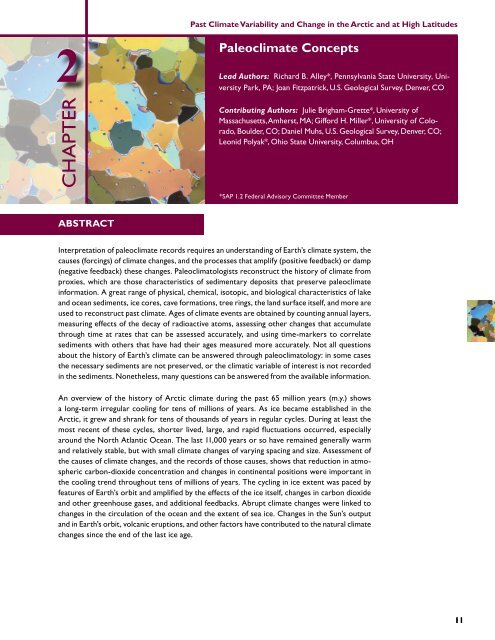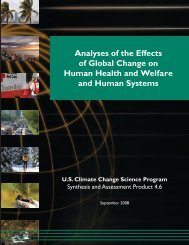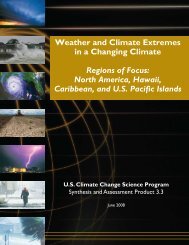Past Climate Variability and Change in the Arctic and at High Latitudes
Past Climate Variability and Change in the Arctic and at High Latitudes
Past Climate Variability and Change in the Arctic and at High Latitudes
You also want an ePaper? Increase the reach of your titles
YUMPU automatically turns print PDFs into web optimized ePapers that Google loves.
2<br />
CHAPTER<br />
ABSTRACT<br />
<strong>Past</strong> <strong>Clim<strong>at</strong>e</strong> <strong>Variability</strong> <strong>and</strong> <strong>Change</strong> <strong>in</strong> <strong>the</strong> <strong>Arctic</strong> <strong>and</strong> <strong>at</strong> <strong>High</strong> L<strong>at</strong>itudes<br />
Paleoclim<strong>at</strong>e Concepts<br />
Lead Authors: Richard B. Alley*, Pennsylvania St<strong>at</strong>e University, University<br />
Park, PA; Joan Fitzp<strong>at</strong>rick, U.S. Geological Survey, Denver, CO<br />
Contribut<strong>in</strong>g Authors: Julie Brigham-Grette*, University of<br />
Massachusetts, Amherst, MA; Gifford H. Miller*, University of Colorado,<br />
Boulder, CO; Daniel Muhs, U.S. Geological Survey, Denver, CO;<br />
Leonid Polyak*, Ohio St<strong>at</strong>e University, Columbus, OH<br />
*SAP 1.2 Federal Advisory Committee Member<br />
Interpret<strong>at</strong>ion of paleoclim<strong>at</strong>e records requires an underst<strong>and</strong><strong>in</strong>g of Earth’s clim<strong>at</strong>e system, <strong>the</strong><br />
causes (forc<strong>in</strong>gs) of clim<strong>at</strong>e changes, <strong>and</strong> <strong>the</strong> processes th<strong>at</strong> amplify (positive feedback) or damp<br />
(neg<strong>at</strong>ive feedback) <strong>the</strong>se changes. Paleoclim<strong>at</strong>ologists reconstruct <strong>the</strong> history of clim<strong>at</strong>e from<br />
proxies, which are those characteristics of sedimentary deposits th<strong>at</strong> preserve paleoclim<strong>at</strong>e<br />
<strong>in</strong>form<strong>at</strong>ion. A gre<strong>at</strong> range of physical, chemical, isotopic, <strong>and</strong> biological characteristics of lake<br />
<strong>and</strong> ocean sediments, ice cores, cave form<strong>at</strong>ions, tree r<strong>in</strong>gs, <strong>the</strong> l<strong>and</strong> surface itself, <strong>and</strong> more are<br />
used to reconstruct past clim<strong>at</strong>e. Ages of clim<strong>at</strong>e events are obta<strong>in</strong>ed by count<strong>in</strong>g annual layers,<br />
measur<strong>in</strong>g effects of <strong>the</strong> decay of radioactive <strong>at</strong>oms, assess<strong>in</strong>g o<strong>the</strong>r changes th<strong>at</strong> accumul<strong>at</strong>e<br />
through time <strong>at</strong> r<strong>at</strong>es th<strong>at</strong> can be assessed accur<strong>at</strong>ely, <strong>and</strong> us<strong>in</strong>g time-markers to correl<strong>at</strong>e<br />
sediments with o<strong>the</strong>rs th<strong>at</strong> have had <strong>the</strong>ir ages measured more accur<strong>at</strong>ely. Not all questions<br />
about <strong>the</strong> history of Earth’s clim<strong>at</strong>e can be answered through paleoclim<strong>at</strong>ology: <strong>in</strong> some cases<br />
<strong>the</strong> necessary sediments are not preserved, or <strong>the</strong> clim<strong>at</strong>ic variable of <strong>in</strong>terest is not recorded<br />
<strong>in</strong> <strong>the</strong> sediments. None<strong>the</strong>less, many questions can be answered from <strong>the</strong> available <strong>in</strong>form<strong>at</strong>ion.<br />
An overview of <strong>the</strong> history of <strong>Arctic</strong> clim<strong>at</strong>e dur<strong>in</strong>g <strong>the</strong> past 65 million years (m.y.) shows<br />
a long-term irregular cool<strong>in</strong>g for tens of millions of years. As ice became established <strong>in</strong> <strong>the</strong><br />
<strong>Arctic</strong>, it grew <strong>and</strong> shrank for tens of thous<strong>and</strong>s of years <strong>in</strong> regular cycles. Dur<strong>in</strong>g <strong>at</strong> least <strong>the</strong><br />
most recent of <strong>the</strong>se cycles, shorter lived, large, <strong>and</strong> rapid fluctu<strong>at</strong>ions occurred, especially<br />
around <strong>the</strong> North Atlantic Ocean. The last 11,000 years or so have rema<strong>in</strong>ed generally warm<br />
<strong>and</strong> rel<strong>at</strong>ively stable, but with small clim<strong>at</strong>e changes of vary<strong>in</strong>g spac<strong>in</strong>g <strong>and</strong> size. Assessment of<br />
<strong>the</strong> causes of clim<strong>at</strong>e changes, <strong>and</strong> <strong>the</strong> records of those causes, shows th<strong>at</strong> reduction <strong>in</strong> <strong>at</strong>mospheric<br />
carbon-dioxide concentr<strong>at</strong>ion <strong>and</strong> changes <strong>in</strong> cont<strong>in</strong>ental positions were important <strong>in</strong><br />
<strong>the</strong> cool<strong>in</strong>g trend throughout tens of millions of years. The cycl<strong>in</strong>g <strong>in</strong> ice extent was paced by<br />
fe<strong>at</strong>ures of Earth’s orbit <strong>and</strong> amplified by <strong>the</strong> effects of <strong>the</strong> ice itself, changes <strong>in</strong> carbon dioxide<br />
<strong>and</strong> o<strong>the</strong>r greenhouse gases, <strong>and</strong> additional feedbacks. Abrupt clim<strong>at</strong>e changes were l<strong>in</strong>ked to<br />
changes <strong>in</strong> <strong>the</strong> circul<strong>at</strong>ion of <strong>the</strong> ocean <strong>and</strong> <strong>the</strong> extent of sea ice. <strong>Change</strong>s <strong>in</strong> <strong>the</strong> Sun’s output<br />
<strong>and</strong> <strong>in</strong> Earth’s orbit, volcanic eruptions, <strong>and</strong> o<strong>the</strong>r factors have contributed to <strong>the</strong> n<strong>at</strong>ural clim<strong>at</strong>e<br />
changes s<strong>in</strong>ce <strong>the</strong> end of <strong>the</strong> last ice age.<br />
11




